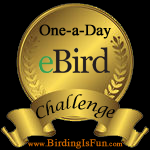I've only lived in New Jersey for three years, but New Jersey is a great place to bird, with so many birds in such an easily traversed state. Every where I go, people stop me and seem to want to talk about the birds they see. Most of these folks probably don't consider themselves birders--though many know quite a bit about the local birds.
These may well be the perfect audience for Rick Wright's new
Field Guide to the Birds of New Jersey--the first in what appears to be a long
line of state guides to be sponsored by the American Birding Association.
The Field Guide to the Birds of New Jersey (henceforth FGBNJ) is an attractive and well produced book that aspires to spark "a lifetime of enjoyment of birds" in NJ. I hope it succeeds.
As is obvious from the title, this guide is focused on a small geographic area--just one U.S. state. Since it is aimed at new or beginning birders, it does not cover every bird found in the Garden State, but does a good job of representing the most common 255 birds that folks are bound to find--including some tough to find birds such as Connecticut Warbler and Northern Saw-Whet Owl that will take some diligent searching to actually observe.
FGBNJ is a photo guide. I'm not a huge fan of photo guides--usually preferring the synthetic abstraction of an artists rendering to the misplaced concreteness of a photo--but for its purpose, this one does a good job. The photos--over 600 in all--are almost universally excellent. Their large format provides good looks at the birds covered. The photos are beautiful.
With beautiful photos,
FGBNJ does a good job of staying out of their way. The layout is simple, with one species to a page or even a two page spread. The text for each bird is one big paragraph, written to be actually read rather than skimmed. Identification tips are usually kept to captions inset into the photos.

My favorite part of bird guides is to hear the voice of the author. In this case, my friend Rick Wright's polished writing is a joy. His summary of each species is a good introduction to the bird, and will be very educational for those learning about each species for the first time. As a clever writer, Rick has tucked away little Easter eggs here and there that will delight. I've never read about a bank collapse in a field guide before! And the imagery is often a joy to read, such as an "ocean sprinkled with the silvery dots of roosting and feeding loons." Such spare but delightful prose hearkens back to the species accounts written by Roger Tory Peterson, the grandfather of all field guide authors. Wright's prose is a fitting and worthy perpetuator of that grand tradition.
In addition to the species accounts,
FGBNJ provides a full checklist to the birds of New Jersey, tips on good birding locations around the state, and the obligatory sections on the parts of a bird and how to identify birds--all geared to the beginner in a clear and concise manner that minimizes jargon--you will find napes, primaries, and secondaries, but as far as I can tell, no tertials. Perfect for beginners.
There are many challenges to writing and producing a guide for beginners, but
FGBNJ and presumably the rest of the American Birding Association series of state guides do provide a good introduction to the birds of the state, and hopefully will provide inspiration to those with casual birding interests to join the ranks of those who start wandering farther and farther afield in their search for avian treasures!
Disclaimer: this review based on a library copy.











